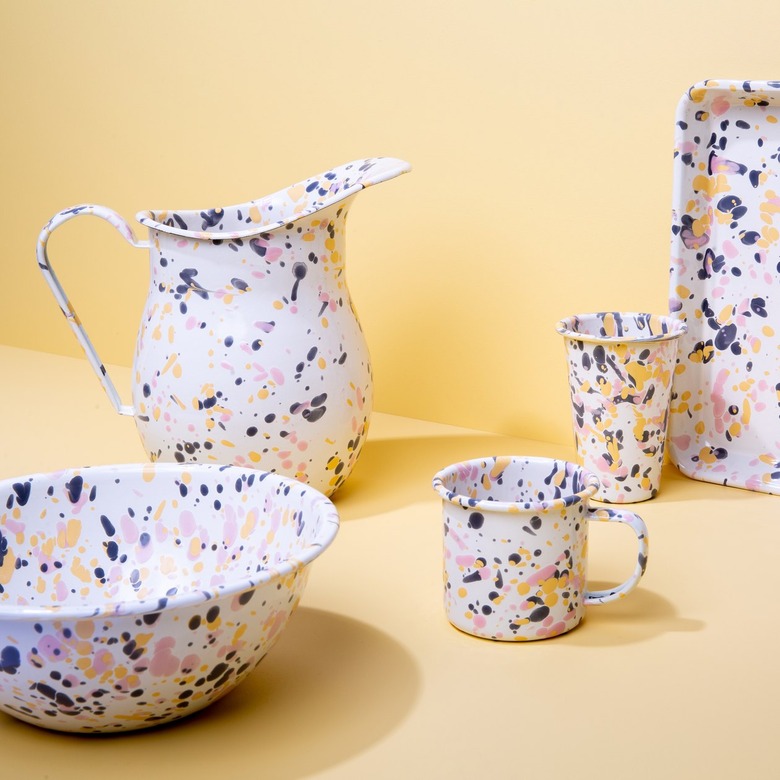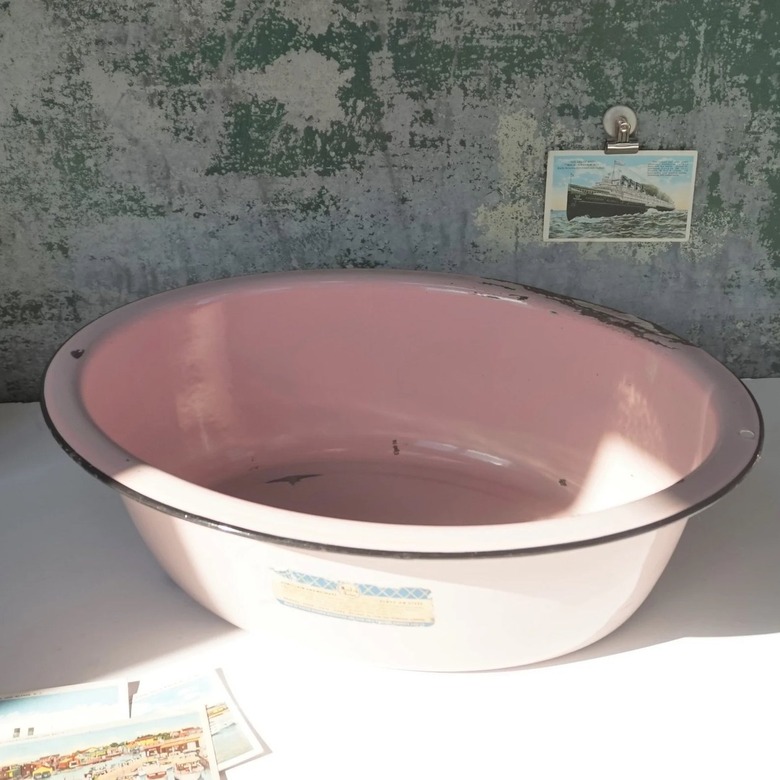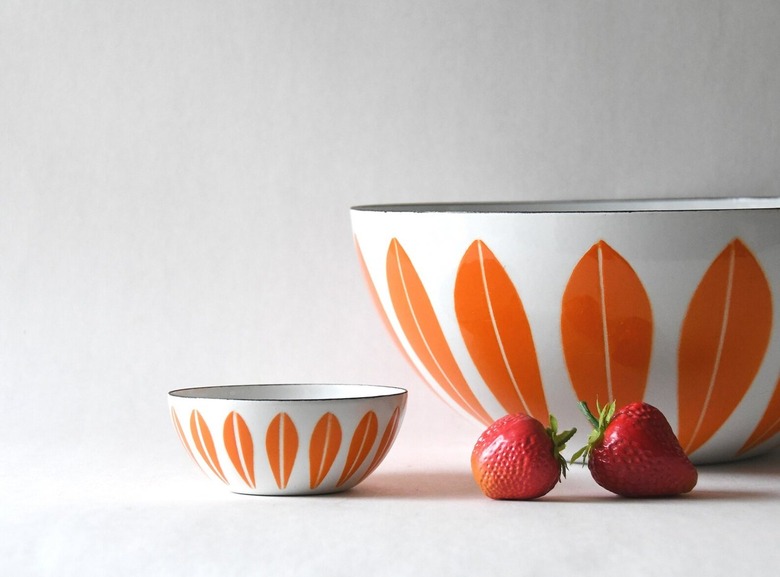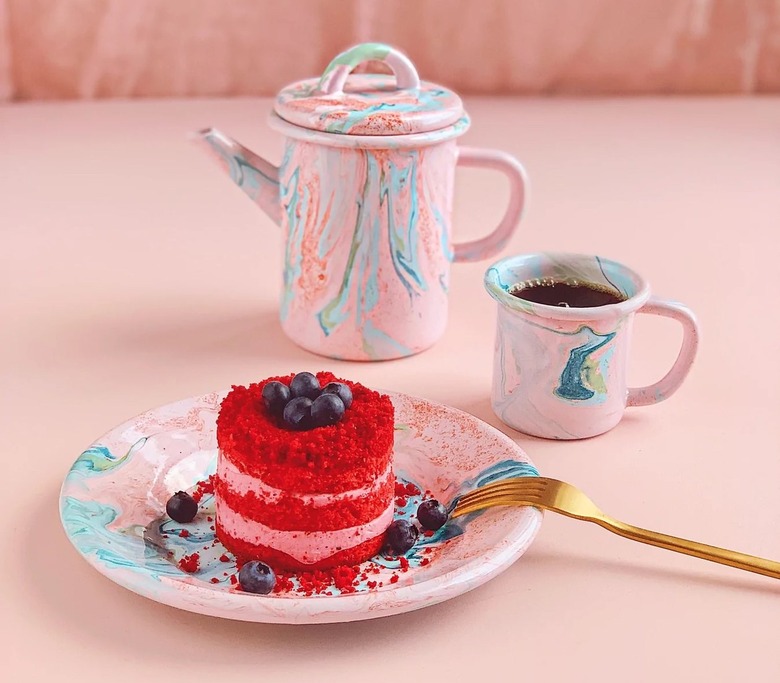How Enamelware Went From Camping-Chic To 21st-Century Trend
Enamel may appear to be a simple coating applied to the exterior of our favorite objects — both vintage and modern, as well as artistic and utilitarian — but the substance's history is far more layered.
"Enameling is a very old medium, while industrial enameling is quite new," enamelist Judy Stone, founder of the Center for Enamel Art, tells Hunker. "Industrial enameling (or porcelain enameling) was developed because of the Industrial Revolution, which created a lot of work in steel and cast iron. That work rusts, so the issue was, 'How do we make iron, cast iron, and steel available to middle class people as functional work?'"
The question Stone poses circulated during the mid- to late-1700s and came to a peak from the 1830s to 1850s in Germany. "Over that period, they figured out that you needed an intermediate coat (or ground coat) to bond to the metal, which would bond to the enamel that we saw," Stone explains, adding that cast iron enameling is very different from that of steel. Plus, this practice didn't start out with the enamel cookware we see today. During that time, you could find enamel coating everything from bathtubs to urinals.
From the 1850s on, companies in the industry also began playing with surfaces by mottling their enamelware and adding texture. That's why Stone says you might see the product referred to as "agateware" or "graniteware." Around this time, enamelware also made its way from western European countries like France and Germany to America, where it became an especially popular kitchenware — and, specifically, campingware — coating due to its cleanability, rust-free properties, usability (it can actually be heated over a fire), reusability, durability, and lightweight nature. Truly, enamelware can do it all.
According to Old and Interesting, a site that details the history of domestic items, popular American enamelware companies were the Philadelphia's Stuart Peterson and Company, New York's Lalance and Grosjean, and the St. Louis Stamping Co. in Missouri, along with Wisconsin's Vollrath, which came about later on. "Catherineholm from Norway and Arabia Finel from Finland are the two most popular midcentury decorative enamelware producers and are highly collectable today," Cara Barde, Crow Canyon Home's owner and president, tells Hunker.
"We had enamel appliances, signs, and architectural elements, and it reached a peak in the 1920s," says Stone. "What happened in the late '40s is plastics took over and made it much cheaper to produce this stuff, and it kind of killed the enamel kitchenware movement."
Despite plastic's emergence, the science and artistry behind enamelware continued to develop. On the technical side of the movement, Stone specifically discusses the removal of carcinogens like lead (which was mostly found in cheaper pieces). Barde, on the artistic side, mentions how people became more creative with how they applied enamelware. In 1977, for example, Crow Canyon originated the splatter pattern on enamelware, which has also become known as "splatterware."
"In modern times, Falcon in the U.K. and Crow Canyon (formally CGS International) in the U.S. have been the enamelware pioneers," Barde adds.
As with most trends from the past, enamelware has seen a recent resurgence. In addition to vintage finds and pieces from classic companies like Crow Canyon and Falcon, several other brands have become known for enamelware. Think Bornn in Turkey, California's The Get Out, Hawkins New York, and Toast, which began in Wales but has expanded throughout Europe and the U.S.
"Enamelware is enjoying a revival as home cooking and dining has become a more popular, less formal, sociable occasion," a Falcon spokesperson tells Hunker. "There also seems to be something quite familiar and warm about enamelware — a lot of people can remember it in their gran's kitchen or using the mugs on a camping trip."
Interestingly, during the pandemic-induced lockdown in 2020, Falcon saw sales of its five-piece bake set double compared to the past year. "This increase came from a resurgence in home cooking and baking (remember banana bread?)," says the brand's spokesperson. When you take into account the upheaval many have experienced the last few years, it's safe to say that the practicality of enamelware can go hand in hand with the comfort produced by its nostalgia and, of course, baked goods.
Barde adds that enamelware also has appeal across generations and locations. "It's equally as popular in the Midwest for its country/old-fashioned feel as it is on the West Coast for its retro, yet modern, look," she says, explaining that many major retailers have also been adding enamelware to product lines the past five to seven years. For instance, Crow Canyon has recently partnered with the likes of Urban Outfitters and West Elm.
Along with, and perhaps prompted by, enamelware's resurgence, we have seen the creation of new colorways and patterns. "For decades, enamelware was seen as a practical item but didn't have any reputation as a trendy design object, as it was designed with plain, muted colors, a lack of patterns, and was produced with lightweight steel," Öykü Thurston, co-founder of Bornn, tells Hunker.
Falcon, in particular, has revitalized its enamelware collection with a new color palette featuring hues like New Pigeon Gray, Pillarbox Red, Coal Black, and Samphire Green. Crow Canyon, on the other hand, has seen a growing market for enamelware that showcases bright color blocks and geometric shapes, while companies like Bornn have become known for its vibrant color pairings.
Of course, creators such as Stone have also continued to make their mark on enamelware through the art of re-enameling, or creating art on top of enameled products. While the materials for this are costly, re-enameling produces one-of-a-kind pieces you can't find elsewhere and has led artists to develop their own specific styles. "My associate, Jeremy Mitchell, has named the results of re-enameling campingware 'glampware' or 'glampingware,'" Stone says.
Whether you're sourcing vintage pieces, purchasing enamelware from well-known or freshly launched companies, or making idiosyncratic re-enameled art, you can count on one thing: Enamelware can and will withstand the test of time.





